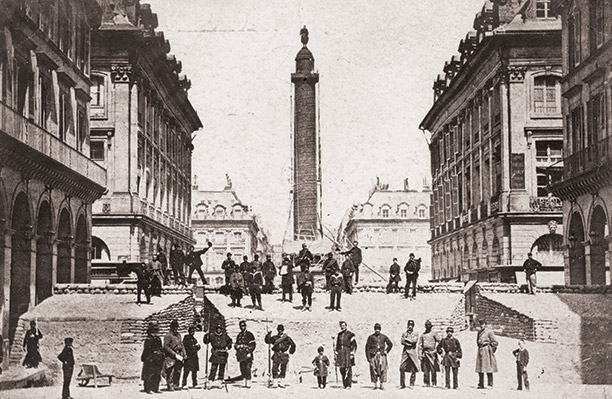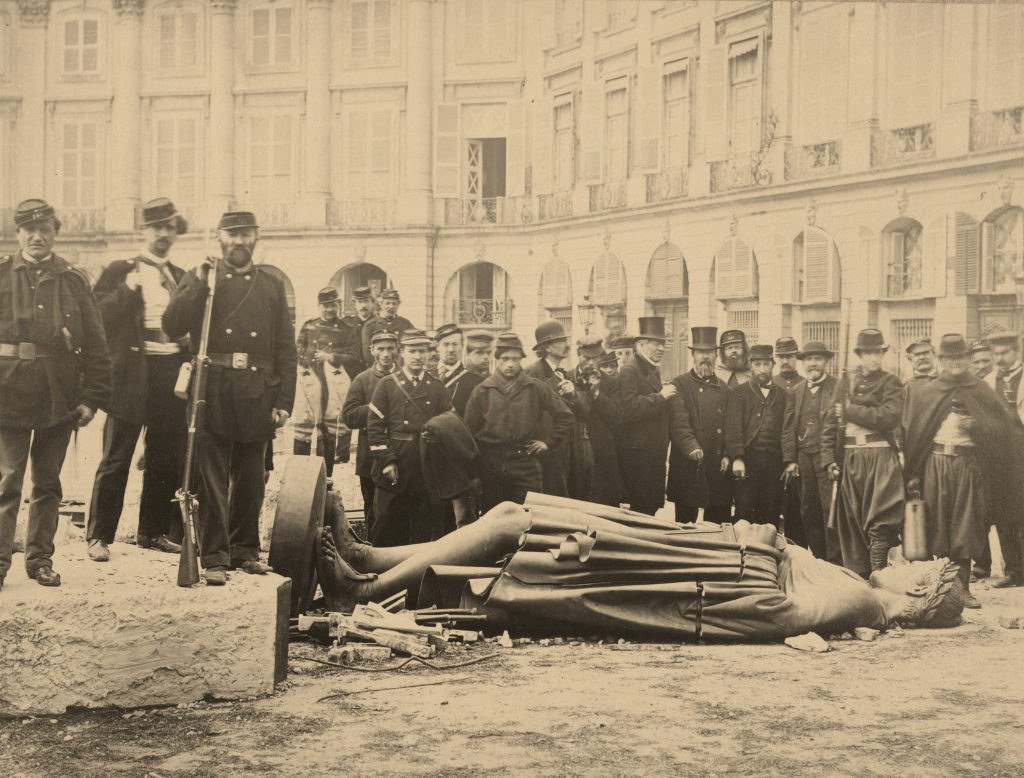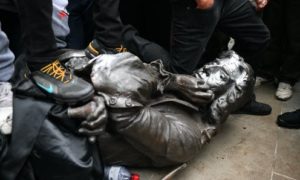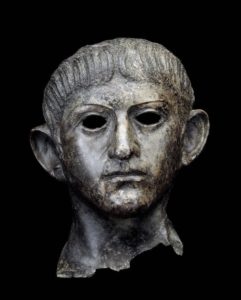Gustave Courbet was born 101 years ago today, but although he remains one of the key figures in nineteenth century art and the roots of modernism, this isn’t about his painting.
During the Franco-Prussian war, Courbet, by then in his 50s and an elder statesman of French art, proposed that the Column erected in the Place Vendôme by Napoleon to commemorate his military victories be pulled down as a symbol of aggressive imperialism, and moved to a location that both neutralised and cast light on its true meaning; he suggested the military hospital, the Hotel des Invalides.

He also suggested that a new monument be made from melted down cannons and dedicated to the people, both French and German, and the peaceful federation of the two nations.
During the brief period of the Paris Commune the next year, the revolutionary government followed half of his advice and issued a decree that the Vendôme column should be demolished – and replaced by a figure representing the Commune itself.
It was duly pulled down, but the Commune was too short-lived for its replacement to be built, and the suggestion that the Place Vendôme column be moved elsewhere was ignored. Instead, when the Commune was overthrown and the government reinstated, Courbet was imprisoned (ironically, he had by then fallen out with the leaders of the Commune too, disagreeing with their more repressive measures) and after his release was charged with the expense of rebuilding the column (he fled France to avoid paying), which remains in the Place Vendôme to this day. Which is a shame. Had Courbet’s original suggestion been followed, the column would have been both a memorial to Napoleon and the might of his armies as it is now, but also to the real meaning of military glory; death, pain and horror.

In the past week, statues have been toppling (notably the statue of slave traders Edward Colston in Bristol and Robert Milligan in London; and it’s good I think; Britain is full of statues and memorials and it’s only right that, rather than seeing them simply as decoration, we should see them as history, and ask who they are and why they are there. And their removal is history too; and I hope that in removing the layers of time and dust and whitewash between us and the past, we can take into account that removing and ignoring parts of history that – for whatever reason – we don’t like, is and always has been part of the problem. A statue that glorifies one man while ignoring the countless, now unfortunately mostly nameless, people he exploited and whose lives he destroyed is an abomination and a symbol of so many things that are wrong with this country; so it should be used to educate and illuminate that sordid corner of history, and to ensure it isn’t forgotten.

I don’t know the best way to do that, but as a matter of course I think that – at the very least – the monuments that litter the country should be looked at, evaluated, explanations added that tell people what history really means. History is the lives of people, not something abstract, and not just those people who pleased the authorities or the populace enough to be celebrated and commemorated – what was the context? Why are we supposed to still care, where does that part of history fit in with where we are now? In a post-modern age it’s not too much to ask that our landscape becomes post-modern too. If statues and monuments of individuals are to mean anything more than personal glory for their subject it doesn’t seem too much to ask to have a basic overview in whatever form (plaque/recording/who knows?) – who is it/what did they do/why are they here* – and the latter two things may only be tenuously linked. In the case of (since he’s in the news) Edward Colston, a few lines can tell a story that I think is worth telling; Edward Colston (1636-1721)/businessman responsible for the slavery of an estimated 84,000 African men, women and children, 19,000 of whom died in transit to the West Indies, many of whom were sadistically branded with his company logo/statue erected as a reward for investing his fortune in British charities, churches and hospitals. The wording would be important and require more thought than I’ve given it here though. I don’t think this would condone anything, but it explains something about history, what the empire was, how it worked and why things are as they are now, in a way that a name and birth/death dates doesn’t.
*immediately you have to admit that this could become absurd; but it needn’t
A statue isn’t a museum, but I don’t see any reason why they shouldn’t do the same job as one; not just preserving, but educating. There’s a parallel argument here too about museums and the repatriation of items stolen from different peoples; and it’s hard to see a good argument against repatriation in an age where the contents of a museum a thousand miles away is as easily accessible to most people as the contents of one a hundred, or fifty miles away. But that’s another discussion.
Importantly, this isn’t – to me at least – an argument for less public art, but for more. Heroines and heroes are not necessarily those people whose fame was great enough to warrant erecting statues of them within living memory. The heroes, as they were then considered, of the Napoleonic wars, or the British Empire, or of World War Two, may not be – and mostly shouldn’t be – our heroes now – but it’s never too late to remember other figures, who exemplify what we retrospectively see as the virtues of their age (deciding who you would memorialise is irresistible; was very glad to see Sylvia Pankhurst memorialised myself). And though some argue (such as Rachel Holmes in this article that I mostly agree with) that there are too many statues in the UK, I don’t think so. The more our history is clear to see and to question, the healthier it is. Hiding it, or limiting public memorials to people we all approve of (impossible) seems the worst kind of self censorship. That said, it gives me some kind of patriotic pride to note that, despite the number of memorials to forgotten military people and monarchs in my own capital city, the best-known statues there are to a writer (albeit one whose role in Scottish history is both illustrious and ambiguous, depending on your political point of view) and and a dog (ideologically pretty okay).

But anyway; time and memory and history are complex, fluid things. There’s a life size bronze head, probably of the Emperor Claudius, in the British Museum which, for whatever reason was removed from its statue and thrown into the river Alde nearly 2000 years ago. The most attractive theory is that the statue was destroyed during Boudicca’s rebellion of native British tribes in AD 61 – and while we can never know if this is true, knowing that the statue existed and that it was dismembered tells us more about Imperialism, resistance and human history than if it had simply been melted down and erased from the world.
The year before Courbet’s birth, Shelley, like Courbet a socialist of sorts, published Ozymandias.
I met a traveller from an antique land,
Who said—“Two vast and trunkless legs of stone
Stand in the desert. . . . Near them, on the sand,
Half sunk a shattered visage lies, whose frown,
And wrinkled lip, and sneer of cold command,
Tell that its sculptor well those passions read
Which yet survive, stamped on these lifeless things,
The hand that mocked them, and the heart that fed;
And on the pedestal, these words appear:
My name is Ozymandias, King of Kings;
Look on my Works, ye Mighty, and despair!
Nothing beside remains. Round the decay
Of that colossal Wreck, boundless and bare
The lone and level sands stretch far away.”.
